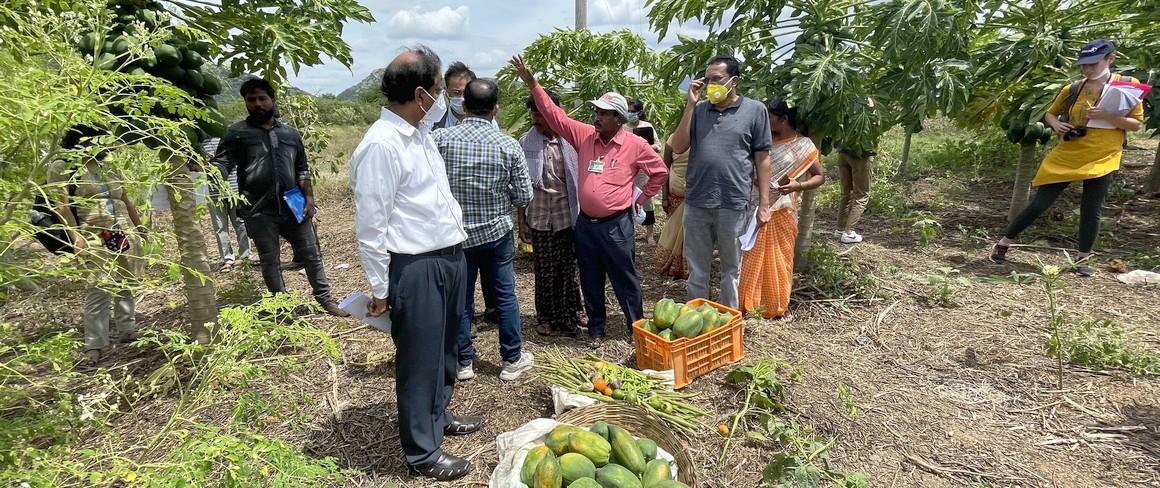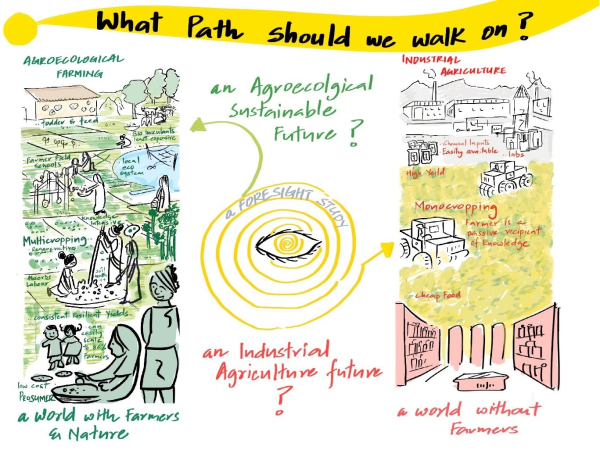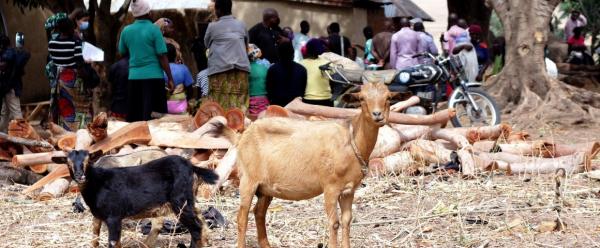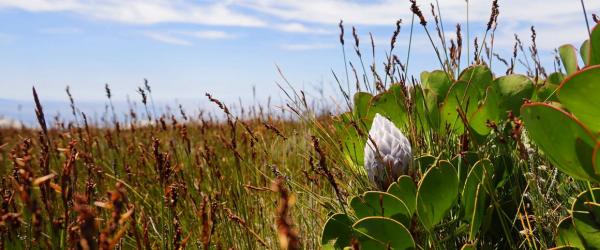Results & impact 28 October 2025
- Home
- CIRAD news
- News
- Participatory foresight initiative in India - Agroeco2050
An unprecedented participatory foresight initiative to foster the agroecological transition in India

Tour of a natural farming plot in the semi-arid district of Anantapur, Andhra Pradesh, in September 2021. This is one of the most arid districts in India © B. Dorin, CIRAD
Crop diversification, soil cover, use of natural biostimulants produced on site, agroforestry, and so on... "natural farming" has already been adopted by almost a million smallholders in Andhra Pradesh, a state in southern India with 53 million inhabitants. The scope of this transition is unprecedented and it provides valuable pointers for a rollout elsewhere, given that India is now the world's most populous country.
The AgroEco2050 collective foresight initiative has been supporting and informing these changes for the past five years. It is led by CIRAD economist Bruno Dorin, and based on the Agribiom model that he built specifically to discuss the industrial food and agriculture model. "The tool acts like a "learning machine" by hybridizing scientific knowledge with other knowledge, such as that of policymakers or farmers", Bruno Dorin explains.
Studying the implications of this vast conversion
This unprecedented transition has drawn the attention of other states in India, central government, and national and international bodies. "As a result, it is important to look into the implications of such a transition, using a rigorous, transparent and multipartite approach", the economist adds.
The initiative has studied two contrasting scenarios for Andhra Pradesh by 2050: conventional industrial farming vs agroecology. It has assessed a range of impacts of the two paths: land use, jobs, soil productivity, incomes, economic growth and inequalities, nutrition, public finance, etc. This was done in close collaboration with the Andhra Pradesh state government (Rythu Sadhikara Samstha - RySS) and FAO. The results will contribute to both national and international debate on agroecology and the future of food and farming systems.
The agroecological transition: beneficial in several respects
If India follows the agroecological path, it will export less rice, but ensure greater food security, in terms of both quantity and quality. "Both scenarios have advantages and disadvantages. The foresight initiative will inform the choices society has to make, by looking beyond the priority given to producing as many calories as possible 'whatever the cost' elsewhere", says Bruno Dorin.
Another advantage of the agroecological scenario is that it would guarantee almost full employment for 20- to 64-year-olds by 2050, while reducing the income gap in relation to non-farmers. According to Agribiom, India will have a billion people in that age group by then. This means even greater demand for jobs, income and equity, which are already in short supply.
Reinventing the future to inform the decisions of the present
The researcher started from the fact that conventional digital models provide a limited, very unimaginative picture, and even perpetuate the established order. "If we want futures other than those generated by conventional data and models, we need to think outside the box and look not just at scientific knowledge, but at other types of knowledge and aspirations", he says.
The AgroEco2050 foresight study rests on three pillars: a group of around 30 experts (scientists, policymakers, farmer representatives, etc), scenario narratives, and a quantitative tool (the Agribiom-India model). The model serves to look back at and discuss past structural changes (since the 1960s), then to check the consistency of the assumptions put forward for the future, from land use to diet through jobs or income disparities.
The Agribiom-India model is used to explore alternative, easily understandable paths, with the emphasis on collective learning rather than on prediction or prescription. Bruno Dorin's approach starts from the assumption that human brains – and exchanges between them – are powerful means of getting to grips with interdependent, particularly complex biophysical and human systems, compensate for a lack of scientific data thanks to other forms of knowledge, and reveal, debate and prioritize values and choices. "For me, that is the fundamental role of tools such as Agribiom."
Just as we pay doctors to take care of our health, we could pay farmers to take care of our climate and ecosystems.
Paying farmers for services rendered to the planet
The agroecological scenario looks more beneficial in several respects. However, to be fully scaled up, the billions of euros of subsidies currently paid to industrial farming would probably have to be replaced by some sort of payments for environmental services (PES), to reward and pay the practices and people making it possible to mitigate climate change (thanks to carbon storage in the soil), resist biotic and abiotic shocks much better in future (thanks to agrobiodiversity in fields and soils), save water and even filter it. "Just as we pay doctors to take care of our health, we could pay millions of micro farmers to take care of our climate and ecosystems", Bruno Dorin concludes.
A similar collective foresight initiative was born in Senegal in 2022, notably including the development of an "Agribiom-Senegal". CIRAD has been supporting the country's agroecological transition for several years, in particular through DyTAES (dynamic for an agroecological transition in Senegal). The initial results should be available shortly.
Since 2016, the Andhra Pradesh state government has been committed to intensifying "natural farming", which is resilient to climate change and managed by local communities, notably women's microcredit groups. The approach is founded on the principles of regenerative agriculture. It centres on soil life, landscape restoration, synergic diversification of plant and animal species, low-input but high-yielding systems, zero pesticides or chemical or organic fertilizers, teaching by and for farmers, and healthy, diverse, affordable food. It is seen as part of the science, movement and practice of agroecology.




























